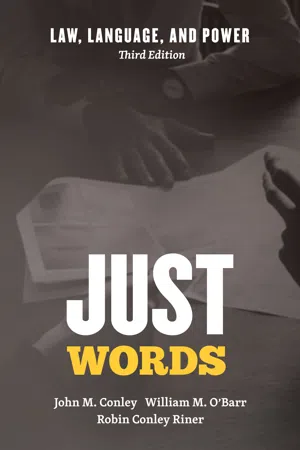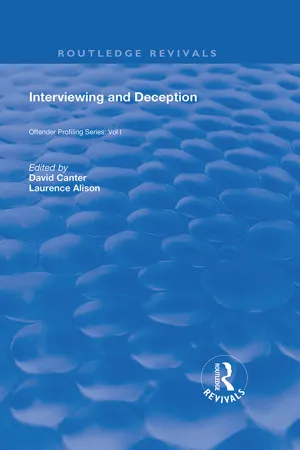Forensic Linguistics
Forensic linguistics is the application of linguistic knowledge and methods to the analysis of language evidence in legal and criminal investigations. It involves examining written or spoken language to determine authorship, authenticity, and meaning, and can be used in areas such as identifying anonymous authors, analyzing threatening communications, and interpreting legal documents.
5 Key excerpts on "Forensic Linguistics"
- eBook - ePub
- R.L. Trask, Peter Stockwell(Authors)
- 2007(Publication Date)
- Routledge(Publisher)
...Forensic Linguistics A relatively recent discipline that applies linguistic techniques as a means of establishing facts in criminal or detective cases. For example, criminals have been tracked down on the basis of their accent signalling where they come from; semantic ambiguities have been highlighted to introduce doubt into criminal convictions; patterns in written texts have been used as part of the psychological profiling of suspects. Forensic linguists explore the language of the criminal court system, policing, and also matters of authorial attribution. See also : applied linguistics Further reading : Cotterill 2002; Gibbons 2003; McMenamin 2002; Shuy 2005, 2006....
- eBook - ePub
Just Words
Law, Language, and Power, Third Edition
- John M. Conley, William M. O'Barr, Robin Conley Riner(Authors)
- 2019(Publication Date)
- University of Chicago Press(Publisher)
...We doubt that many trial judges would admit the sort of opinions that have been attributed to Foster in the Ramsey case. The point we seek to make is more general, however. It is that those who seek to appear in court as linguistic experts must satisfy not their fellow linguists but judges seeking assurances of “reliability.” We remind our readers to keep this standard in mind as they consider the examples that follow. Defining Forensic Linguistics The word forensic, derived from the Latin forum, means (according to the Oxford English Dictionary) “of, used in, or pertaining to a court of law.” Thus, in its most straightforward sense, Forensic Linguistics means “linguistic expertise applied to legal cases.” It should be noted, however, that many people now use the term as synonymous with “law and language.” For example, in his preface to John Gibbons’s Forensic Linguistics: An Introduction to Language in the Justice System (2003), the distinguished linguist Peter Trudgill locates it within the context of applied linguistics (itself defined as the application of the findings of linguistic research to the solution of real-world problems). For Trudgill (2003:vi), Forensic Linguistics is “the application of linguistic research—in socio-linguistic areas such as discourse analysis, dialectology, linguistic variation and stylistics, and other core linguistic areas—to different societal issues connected with the law.” Gibbons (2003:12) himself distinguishes between a narrow and a broad definition of Forensic Linguistics. In the narrow sense, the term refers to linguistic evidence used in and by the law...
- eBook - ePub
- David Canter, Laurence Alison, David Canter, Laurence Alison(Authors)
- 2018(Publication Date)
- Routledge(Publisher)
...By contrast, in the past five years there has been a rapid growth in the frequency with which Courts in a series of countries have called on the expertise of linguists and, in consequence, there is now a developing methodology and a growing number of linguists who act as expert witnesses, a few even on a full time basis (see Levi, 1994b). The International Association of Forensic Linguists was established in 1993 and the journal, Forensic Linguistics: the International Journal of Speech, Language and the Law appeared for the first time in 1994. What do Forensic Linguists do? Forensic language analysis can be divided into three sub-areas; forensic handwriting analysis, forensic phonetics and Forensic Linguistics. Forensic handwriting analysts are concerned with the marks left by writing on a page. They may be asked by whose hand or with which typewriter or printer a text was produced (Davis, 1986) or, more recently, to decipher, by means of a technique called Electro-Static Deposition Analysis (ESDA), the impressions left on a given page by what was written on the sheet(s) above and then to use that knowledge to express an opinion about the authenticity, date and/or timing of the writing on the page in question, (Davis, 1994). Forensic phoneticians focus on the sounds produced when someone speaks; sometimes they are called on simply to identify the accent of an unknown voice tape-recorded while making obscene or threatening phone calls, but much more often they are asked to compare tape-recorded samples of known speakers, who are usually already suspects, with samples of an unknown voice...
- eBook - ePub
- Patricia Friedrich(Author)
- 2019(Publication Date)
- Routledge(Publisher)
...On the other hand, the greater partnership of Forensic Linguistics with computer scientists can allow for the development of programs that look at large quantities of linguistic data with the goal of solving linguistic puzzles in the real world. What is Forensic Linguistics? If Forensic Linguistics was to be summarized in one sentence, it would be that it is the science of author identification. Relying on the assumption that individuals have idiolects (i.e., individual dialects, however multi-layered), Forensic Linguistics postulates that if you identify and isolate the features of that idiolect in a text (written or oral), and compare and contrast those features in a text of known authorship with those in a suspect text, one can arrive at the author or discard the possibility that a particular individual is the author. This can be done at a more individualized level (e.g., comparing one suspect text message to 25 known texts by a given person) or, in corpus studies, against a large database of texts (e.g., features of a novel against many works from that period). While this is an extremely simplified summary of what Forensic Linguistics can do, it brings what is a rich, complex application of linguistics to a concrete level. Ariani et al. (2014, pp. 223–224), provide a much broader picture by expanding the realm and the possibilities of Forensic Linguistics (as applied to legal domains) to include, besides author identification, “forensic stylistics, discourse analysis,” linguistic dialectology, “forensic phonetics, forensic transcription,” and the study of variation (both intra- and inter-author variation)...
- eBook - ePub
Criminal Psychology
A Beginner's Guide
- Ray Bull, Claire Cooke, Ruth Hatcher(Authors)
- 2009(Publication Date)
- Oneworld Publications(Publisher)
...Two other areas in which linguists might give expert evidence include questions of identification and questions of meaning and use. Identification questions might concern either spoken language using voice analysis or written language. If you received a telephone threat or an abusive letter a forensic linguist might be able to help identify who was behind them. With regard to disputes of meaning, usually these fall to lawyers to debate, but sometimes a linguist can assist. In one case Jerry McMenamin, a Californian forensic linguist, examined the common understanding of the word ‘accident’ to argue that under an insurance claim a cot-death might constitute an accident. An example of a linguist giving evidence of language use is discussed below. Roger Shuy, an eminent American forensic linguist, argues that although John DeLorean, a sports car manufacturer, was set up to be involved in a nefarious drug deal, examination of the covert tapes show that he did not understand that this was the case and that because of this he never consented to take part (Shuy 1993). Identification evidence Forensic linguists tend to agree that there is no such thing as a linguistic fingerprint; a consistent way in which an individual uses language across different situations and contexts. As discussed in the chapter on profiling and case linkage, however, it does seem that we fall into habits of repeating behaviours and in this tendency language behaviour is no different. In language individuals seem to reuse words, phrases and linguistic constructions, and this can be useful if the author of a text needs to be identified. One of the highest profile cases where this tendency has been useful involved an FBI investigation into an individual who became known as the Unabomber...




